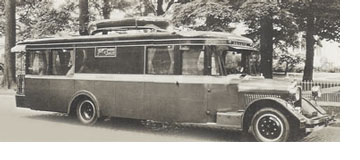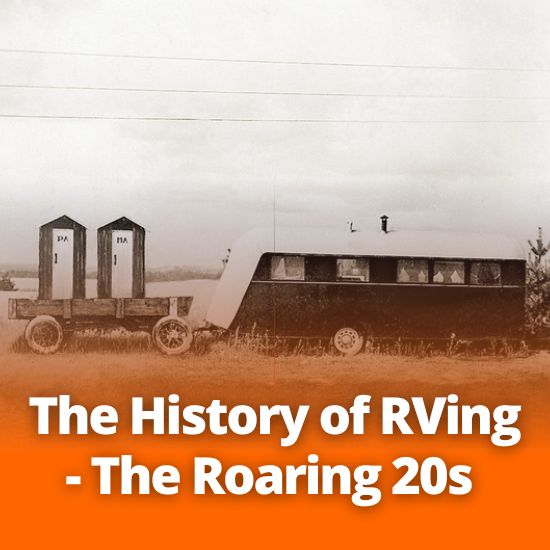
The History of RVing - The Roaring 20s
When we last left off, the 1910s saw commercially built RVs hit the tracks, the Conklin Gypsy Van, and ‘motor bungalows’ (if you missed it, check out) but the roaring 20s, of flappers, relaxed inhibitions, economic prosperity, art deco and, of course:
Sweet Jazz Music
It was also a grand evolution of time for the RVs. Just as people hit dance floors in tassel dresses or two-toned spectators, RVs started being offered as custom builds (we can see the seeds here of how new-model buyers in the future will be able to choose their floorplans and finishes).
But let’s start with a refresh; up until the 20s these custom built campers were often mounted on a Model T car chassis, the most common make of automobile at the time. An example of this is the Nomad house car (seen below) built of the chassis of a Ford Model TT ( according to The Henry Ford Museum, it was remounted on a Graham Brothers truck chassis in 1928), owned by novelists John Stanton and Mary Chapman who, over 47 years, traveled in it to 24 of the US states.
But there were also a couple complete, ready-to-roll motorhomes on the market. For example, the Hudson-Essex ‘Pullman Coach’ and REO’s Speedwagon Camper, pictured below.
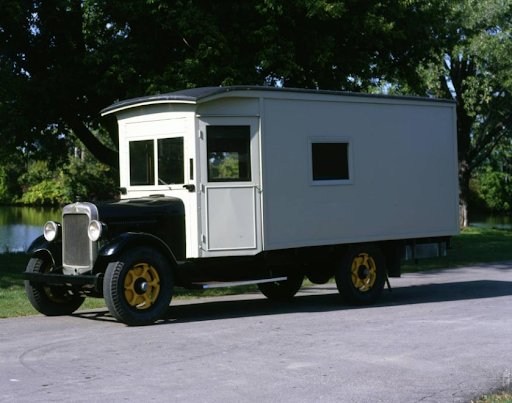
(1923 ‘Nomad’ Motorhome, as seen at the Henry Ford Museum, Michigan)
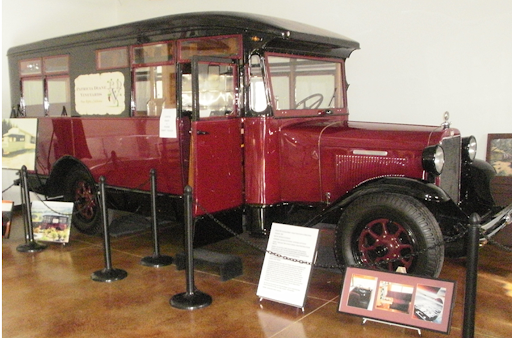
(1929 REO Speedwagon featured at the Woodland Auto Display, California)
The 20s were the steady incline of camping as an escape from life. In 1923, J.C. Long and John D. Long published Motor Camping, a book of detailed guidance on road tripping and trailer camping. They claimed that Americans who resided in urban areas were “possessed of the desire to be somewhere else.” And for them, the answer to this desire was trailer camping (you see, they’re just like us). But it wasn’t just cheerful, improve your life publications, trailer manufacturers started popping up this decade across Canada and the USA, advertisements declaring how their trailers were what you needed to properly enjoy the great outdoors in a civilized manner.
Among these trailers were the increasingly popular tent campers, proto-models of today’s pop-ups. They were a hot ticket market item but had their drawbacks as Arthur G. Sherman discovered.
In 1928 on a family camping trip north of Detroit, the Sherman’s towed a tent trailer claiming to be a five-minute set-up and completely waterproof. Which would’ve been incredibly handy when, upon their first time setting it up, it started to rain…a lot. So of course the Shermans got soaked when they “couldn’t master it after an hour’s wrestling.”
Like many manufacturing developments, this inspired Arthur Sherman to make something better and more practical, because spite is the best motivator particularly if it came about from wet socks and underwear.
He wasn’t a carpenter or designer by trade (in fact he was a bacteriologist), so the initial design wasn’t the most…let’s say aesthetically pleasing. It was a six-foot wide, nine-foot long masonite body with a low ceiling, barely taller than their car. There was a small ventilation window on either side, with two more at the front, cupboards, an icebox, stove, built-in furniture and storage, all divided to either side of a narrow center aisle. While it was basically an overrated box, it did have something going for it that tent trailers didn’t: it was solid, required no folding to set-up or take down and most importantly, it was waterproof.
When other campers began showing interest in this new style, Sherman saw an opportunity. He had two more ‘Covered Wagons’ built, one of which was displayed at the January 1930 Detroit Auto Show. The price was set at $400 USD (which, with inflation, is equal to approximately $7,175 today). Even though this was expensive for the day, Sherman sold 118 units by the end of the show, birthing the Covered Wagon Company and laying the road for the future of the RV industry.
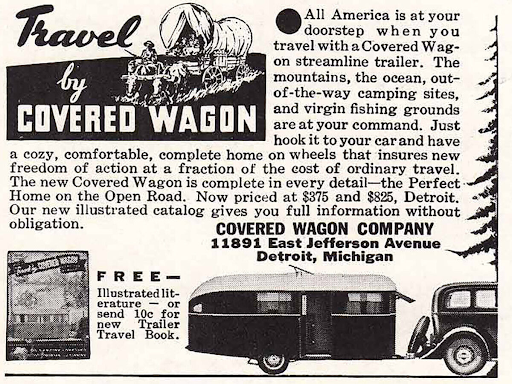
The last few years of the 20s was a landslide of new RVs.
In 1927, a custom RV was built by Leonard S. Whittier on the chassis of a Brockway model ‘H’ bus called the Flordellen. With wicker furniture, bookcases, and a kitchen complete with fridge, sink, and electric stove, there was even a septic tank to complete it!
And that’s just the appetizer as we come to one of the most fantastical of 20s builds: the Aerocar Land Yacht. This absolutely bonkers motorhome was created by Glenn Curtiss, an aviator who had it constructed on “aircraft principles” with a light, metal tube frame braced by wired cables. And I do mean fantastical, because one version of the yacht featured an office with desk and wicker chairs, rear galley kitchen and restroom, and a glass roofed observatory cockpit. It sounds like something out of The Jetsons, and looked like it too.
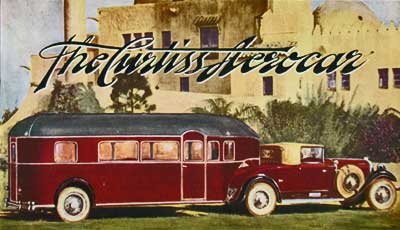
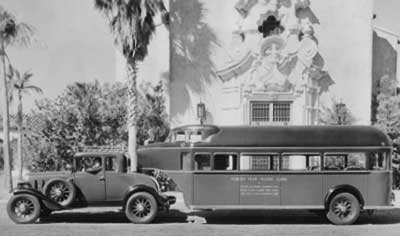
A whole lot can be said of this beast, so we’ll save it for another time.
Then closing out the decade there was the Gilkie tent trailer in 1928 (returning to the pop-ups I see), and a teardrop trailer in 1929 created by Wallace Merle Byam.
The Gilkie trailer by E.P. Gilkison & Sons in Indiana feature two 54”, fold-out beds framed by wired screen windows and “waterproof, mildew proof army duck tent” on a two wheel trailer frame.
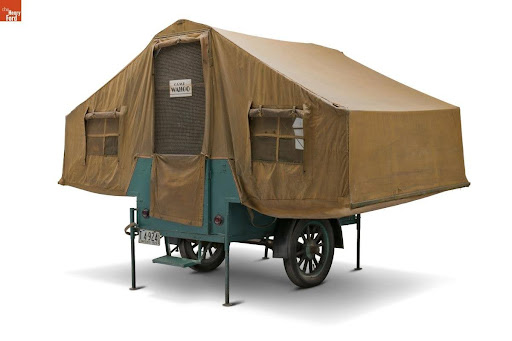
And the Byam trailer boasts the honor of being the first teardrop trailer! Creator of the Airstream, Byam started as all did with a tent contraption, later adjusting it to the teardrop form we know today for greater durability and weather protection.
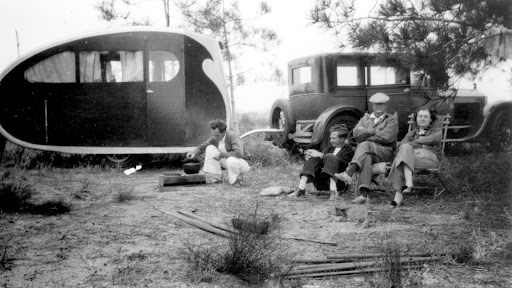
(a photo from the Estate of Helen Byam Schwamborn: an early 1930s camping trip with the Byam Car Cruiser)
But the real reason he wanted to create this trailer? Love for his first wife, Marion. Marion, who reportedly did not enjoy sleeping on the ground when camping, was his inspiration as he went from a tent atop a Model T chassis, to a solid structure with space to sleep, a stove, and ice chest. So even while that marriage didn’t endure, his passion for innovation in the rapidly burgeoning outdoor leisure market continued.

